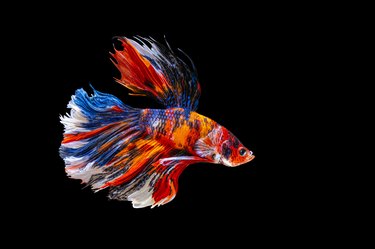Are your betta fish in a plant vase? This living situation should be temporary at best since fish need enough space to swim, and they need filtration for clean water. If you acquired your pet betta fish in a flower vase, you'll want to quickly transfer him to an appropriate tank and then set it up with the right accessories so he can swim freely and thrive. You can still include pretty greenery and even silk aquarium plants for bettas to enjoy.

Video of the Day
Pick a proper aquarium
Alas, the betta fish in a plant vase setup that you've just purchased or won by tossing ping-pong balls at a county fair isn't tenable for a piscine pet. In fact, putting a betta fish in a flower vase with a plant growing on top could actually starve your fish to death. Your best bet is to stash this vase and plant and release your betta fish to an environment that's closer to her natural habitat, which is a tank or aquarium that's filled with 3 gallons of water for every inch of fish.
Video of the Day
Add a filter
Inferior water quality is the number one reason pet fish get sick. You can rectify this by purchasing a liquid test kit to check the water in your fish's tank. A testing kit like this will reveal the proper levels of ammonia and nitrites that a betta fish needs to survive. The next step is to add a filter to the tank to remove fish waste and old food bits. An air pump is also required in order to provide oxygen to your betta as well as a tank thermometer so you can tell whether the water is warm enough to sustain fish life.
Clean the tank
A clean tank is a healthy tank for your betta fish, so be certain the plants, filter, and air pump are well-scrubbed with hot water and a tiny brush before you put them inside (a toothbrush works well for this task). If you're using glass spray, remove your fish as you clean the tank on both sides. But if you're just vacuuming the gravel bits in the bottom, you can leave the tank half full of water and your fish can swim while you tidy up. When it's clean, refill the tank with water that's been treated to remove chlorine, a substance that's fatal to fish.
To keep your tank pristine, be sure the way you're feeding your fish isn't adding to the muck and grime inside. Too much fish food fed too often means uneaten particles can linger in the tank and then break down into potentially dangerous and even toxic components, such as ammonia and nitrites. A good rule of thumb is to offer only the amount of fish food your betta can consume in about 30 seconds and no more. Be sure to store fish food in a tightly sealed container that's kept in a cool, dark place for maximum freshness.
Silk aquarium plants for bettas
Plastic or silk aquarium plants for bettas are a lovely addition to your pet's watery home, and they make good sense in terms of tank cleanliness. Fake greens like these won't break down in the water, and your fish won't be tempted to nibble on them. Just skip metal decorations, as they'll likely rust. Clean plastic plants or other accessories well before adding them to the tank.
Having plants, tiny houses, or other tank accents can also provide your fish with places to hide and hang out when he needs a break. Adding live plants is fine as well, in part because they act as natural filters, cleaning the water by removing harmful chemicals and bits of fish waste, and they offer extra oxygen for your gilled guy to breathe.